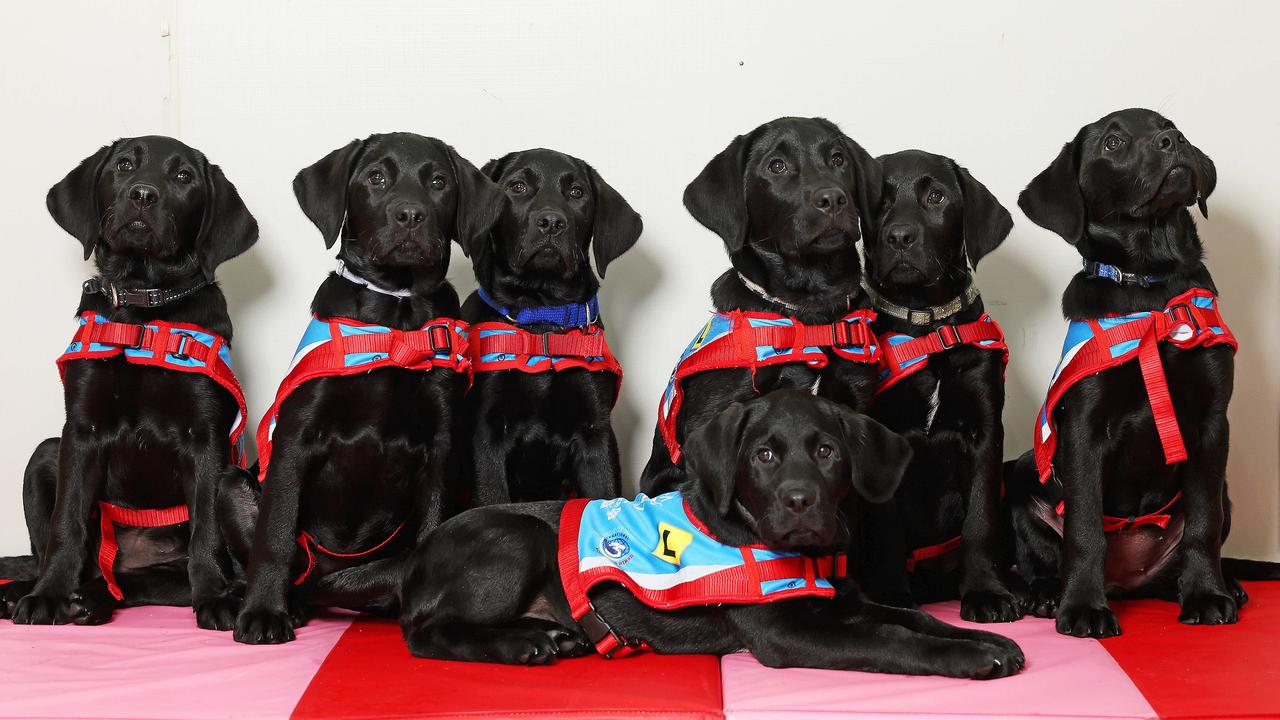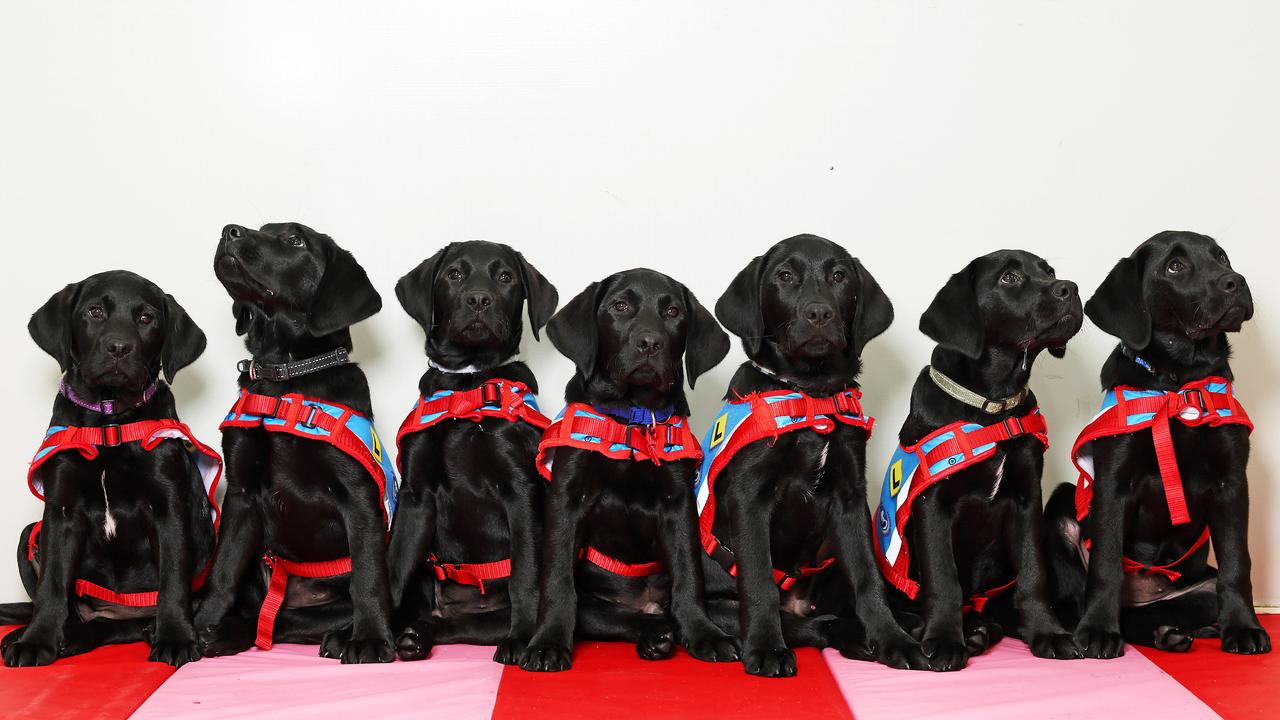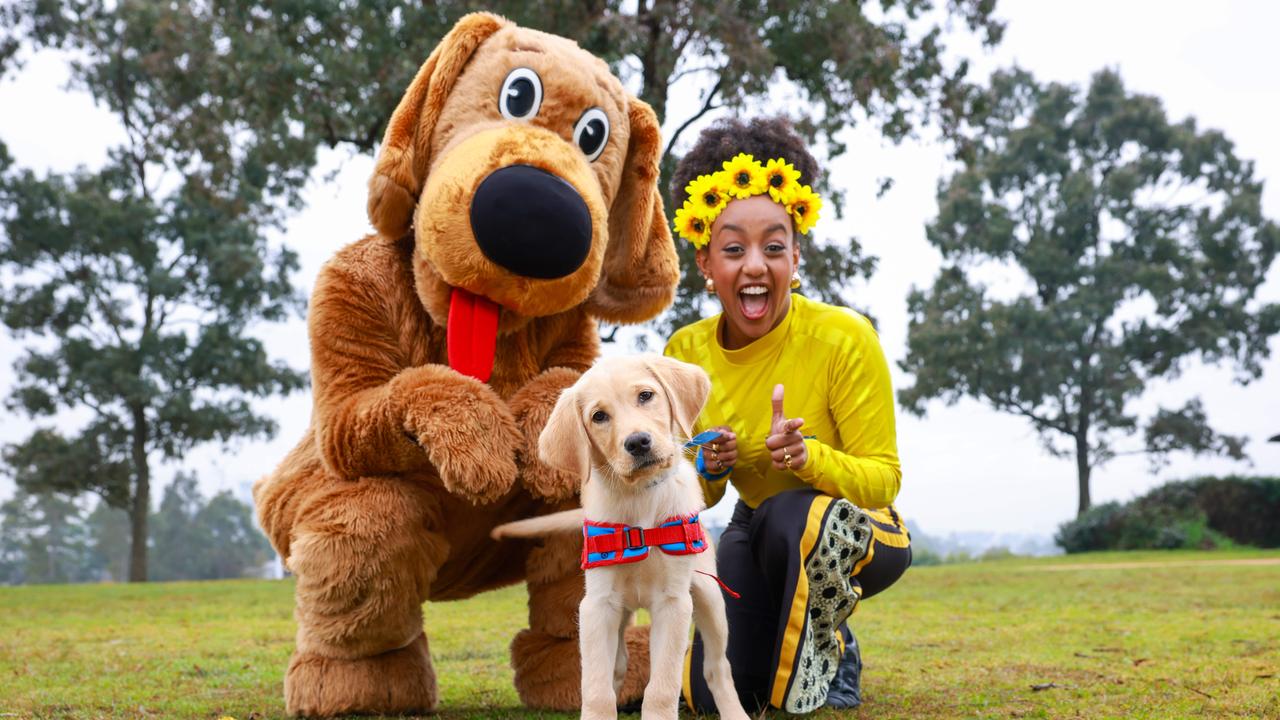Cute ‘E-litter’ puppies start ADA assistance dog training
Not only are they adorable, these puppies have a special ability to improve the lives of whoever takes them home. Find out what sets them apart and how you can help them help others

READING LEVEL: GREEN
Seven adorable puppies are about to embark on their first day of puppy kindergarten, training to become the newest assistance dogs.
Dubbed the “E-litter”, Echo, Everly, Elroy, Emerald, Euan, Else and Eleanor are the next puppies who will spend the next 24 months being trained by Assistance Dogs Australia (ADA).
They will then spend their lives as companions for children and adults with physical and psychosocial* disabilities, such as severe PTS* and complex autism*.
For 15-year-old Max, nothing has helped him as much as his Autism Assistance Dog, Watson.
Not only is Watson a “best friend”, but he also helps Max to regulate* at home and school.
“People aren’t going to be able to help him, but Watson can,” Max’s mother, Selena McMurray said.

An assistance dog has made a big difference to Max’s quality of life, according to his mum, who says he can now “do things that (he) wouldn’t normally do because (he) doesn’t have that barrier anymore.”
And Watson isn’t only helping Max, he benefits the whole household.
“He helps all of us, he knows when someone needs support or if something’s up … he instantly will calm us down,” Ms McMurray said.
The “E-litter” is only one group of puppies who will become four-legged companions, and the ADA is hoping increased community support will help them train more puppies and open up more frequent assistance dog applications.
“Training a puppy is a complex and expensive job, making it a long wait for those in need, but we know that our remarkable dogs completely transform lives,” ADA CEO Tim Taylor said.

WHAT ARE ASSISTANCE DOGS?
Assistance dogs are furry friends that have been specially trained to support their humans who are living with a disability. In fact they are even “trained to alleviate* the effects of their human’s disability as a medical aid*,” states the Assistance Dogs Australia (ADA) website.
Recognised under Australian law and protected by the Disability Discrimination Act* 1992, assistance dogs are allowed to travel on public transport and are allowed to go in almost all public spaces in order to support their human.
“Every year, assistance dogs undergo an examination, called the Public Access Test, which essentially re-accredits* them to go everywhere with their human (except for sterile areas* like operating theatres),” the site says.

ADA trains assistance dogs to support people living with physical disabilities as well as assistance dogs to support children on the autism spectrum and their families.
Assistance dogs are able to support people with physical disabilities, such as cerebral palsy*, spina bifida* and multiple sclerosis* by picking up items, opening and closing doors and drawers, emptying washing machines and barking if their human falls out of their wheelchair. They can also press the buttons at traffic lights and in lifts and retrieve the phone when needed.
For children and families living with autism, assistance dogs have been shown to bring families together and provide support in the areas of building communication skills, confidence, independence, building empathy, reducing anxiety, tactile perception* and providing routine – to name just a few, says the ADA website.


“Assistance dogs, in addition to their supporter skills, have been trained to meet a very high standard of behaviour and hygiene. Their handlers are also trained to help them maintain their skills,” the site states.
“For example, assistance dogs are trained to toilet on command and not in indoor or public spaces. On public transport, assistance dogs know how to position themselves out of the way and to remain so quiet, no-one would know they are there.”
The ADA says it takes two years to train and costs up to $60,000 to provide an assistance dog free of charge to each person in need. The charity doesn’t receive government funding and relies completely on donations from the public.
ADA accepts donations as well as volunteers to help care for and/or educate dogs and puppies in the program. Visit assistancedogs.org.au/support-us/ for more information.
POLL
GLOSSARY
- psychosocial: a disability that comes from a mental health condition
- PTS: post traumatic stress, when you have physical symptoms, like a racing heart or sweaty palms, from a previous stressful event
- autism: a neurodevelopmental condition that affects how a person’s brain develops and functions and can present as a varied spectrum of symptoms
- regulate: manage feelings, emotions and the sensations of the body
- alleviate: make suffering less severe
- medical aid: a method of treating a medical problem or disorder
- Disability Discrimination Act: an Australian law that makes it unlawful to discriminate against people with disabilities
- re-accredits: makes it official that the dogs are allowed in all public spaces
- sterile areas: areas that must be free of any germs for health and hygiene purposes
- cerebral palsy: a condition that causes floppy or rigid limbs and involuntary movements due to abnormal brain development
- spina bifida: a birth defect that stops the spine from developing that often causes paralysis of the lower limbs
- multiple sclerosis: (MS) a disease where the immune system attacks the protective covering of the nerves, causing numbness, vision problems and troubling walking
- tactile perception: the brain’s ability to interpret and understand sensory information from the skin through the sense of touch, especially through the hands
EXTRA READING
Australia’s big cats’ cub bonanza
Guide dog trainers guide others
Guide Dogs celebrate 60 years of helping
QUICK QUIZ
1. Why are the dogs called the “E-litter”?
2. How long does it take to train an assistance dog?
3. What yearly exam do assistance dogs have to take?
4. What does the exam enable the dogs to do if they pass?
5. How much does it cost to provide each disabled person with an assistance dog?
LISTEN TO THIS STORY
CLASSROOM ACTIVITIES
1. Assistance dogs Australia
The Kids News article states all the reasons why assistance dogs are lifesaving for so many living with different disabilities, but the cost of $60,000 a dog for breeding and training makes it hard for a lot of people to access.
If you wanted an assistance dog for a friend or family living with one of these conditions, how could you offer to pay or fundraise to get one of these special dogs?
Work with a partner and list some ideas of how you could get more of these dogs out to the people who need them.
Time: allow 15 minutes to complete this activity
Curriculum Links: English, Health and Physical Education, Personal and Social, Critical and Creative Thinking
2. Extension
The breed of dogs used for this important program are labradors, golden retrievers, and labrador golden retriever crosses. What do you know about these breeds that makes them the best assistance dogs?
Do you think in the future they might look into training other people’s dogs to lessen the cost?
Time: allow 10 minutes to complete this activity
Curriculum Links: English, Personal and Social, Critical and Creative Thinking
VCOP ACTIVITY
Read this!
A headline on an article – or a title on your text – should capture the attention of the audience, telling them to read this now. So choosing the perfect words for a headline or title is very important.
Create three new headlines for the events that took place in this article. Remember, what you write and how you write it will set the pace for the whole text, so make sure it matches.
Read out your headlines to a partner and discuss what the article will be about based on the headline you created. Discuss the tone and mood you set in just your few, short words. Does it do the article justice? Will it capture the audience’s attention the way you hoped? Would you want to read more?
Consider how a headline or title is similar to using short, sharp sentences throughout your text. They can be just as important as complex ones. Go through the last text you wrote and highlight any short, sharp sentences that capture the audience.

